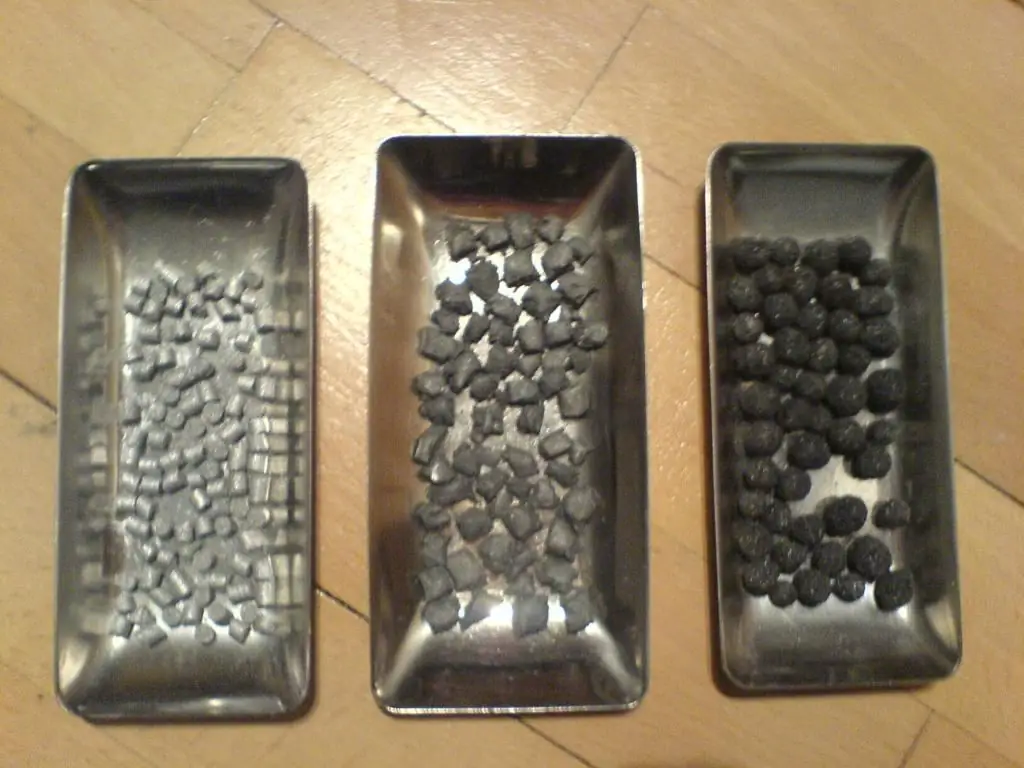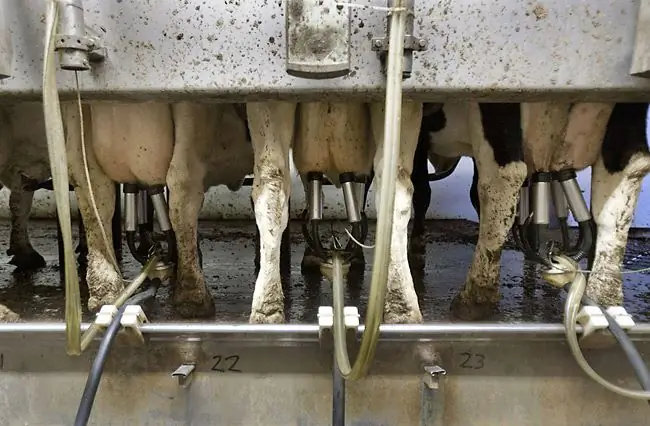2026 Author: Howard Calhoun | [email protected]. Last modified: 2025-01-24 13:10:39
Currently, there are more than 400 factories specializing in the production of beer in Russia. During the production of this alcoholic beverage, a large amount of various kinds of waste is generated. The lion's share of their mass is made up of beer pellets. Unfortunately, at the moment, in most cases, enterprises send it for recycling. Meanwhile, the product is very useful and can be used in various areas of the national economy. The use of pellets as animal feed and fertilizer is considered especially appropriate.
What is a grain of beer
This product is a well-mixed mass, which includes particles of kernels and shells of grains. It remains brewer's grains in the process of developing barley wort. The main feature of this secondary product of brewing is that it contains just a huge amount of nutrients and beneficial trace elements. Therefore, in agriculture, it is used primarily as a source of protein in animal feed.

Key Features
In its normal state, beer pelletcontains about 80% water. You can not store it in this form for more than three days. After a certain time (depending on the air temperature), the pellet turns sour and loses its useful properties. Moreover, various kinds of toxins begin to accumulate in it. Therefore, it is not advisable to transport this product over long distances. In order to avoid souring and reduce the weight of the grain intended for transportation, it is preliminarily dried. From 3-4 tons of wet mass, 1 ton of dry product is usually obtained. There is also equipment for the production of granulated brewer's grains.
Beer pellet: ingredients
There are really a lot of various useful substances in beer grains. Information about what exactly is included in the composition of the dried product and in what quantities can be obtained from the table below.
| Element | Indicator (%) |
| Proteins | 23, 44% |
| Fats | 7, 75% |
| Fiber | 14, 33% |
| Ash | 2, 5% |
| BEV | 43, 44% |
| Water | 6, 87% |
Besides this, the composition of brewer's grains includes such trace elements as:
- zinc - 105 mg/kg;
- iron - 205mg/kg;
- copper - 15 mg/kg;
- phosphorus - 0.5 mg/kg;
- calcium - 0.37mg/kg.
Beer grain also contains a very large amount of amino acids (glycine, alanine, threonine, etc.).

Granular product
The advantages of such pellets include, first of all, a long shelf life and low cost of transportation. Produce a granular product as follows:
- raw grain is dried;
- hard dry mass is ground into flour;
- compress the bulk product into granules on special equipment.
Main uses
In agriculture, grain pellets are most often used for fattening pigs, small cattle and small cattle. Thus, one of the main areas of its use is the production of animal feed. Also, pellets are often used as a fertilizer in the cultivation of cultivated plants. Another area of the national economy in which pellets are used is the food industry. Most often it is used in baking flour products for dietary purposes. In this case, it serves as a valuable source of dietary fiber. Sometimes pellets are also used as biofuels. Most often, it is used in this way by the breweries themselves.

Use of pellets for fattening animals
In its pure form, this product is not given to cows, sheep and pigs. Usually the grain is simply part of various kinds of compound feed. In terms of a positive effect on the body of animals, it is considered even moreuseful than bran. However, feeding it in large quantities or in its pure form is highly discouraged. Dairy cows, for example, are usually given no more than 6-8 kg per day.
Abroad, spent grains are often ensiled in long narrow trenches. We do not use this method. However, when feeding pigs, lactic acid starter is sometimes added to dry grains. This increases the moisture of the product, and therefore, accelerates its digestibility.

Use for fattening poultry
Dry brewer's grains are used in the cultivation of not only farm animals, but also poultry. Feeding it to laying hens allows you to increase egg production. When brewer's grains are mixed into the feed for broilers, the meat yield increases. In its pure form, the bird is not given brewer's grains, as well as animals. Some disadvantage of this product is that it has a bitter taste. Therefore, the bird eats it not too willingly. Meanwhile, correcting the situation is not particularly difficult. In private household plots, grains are added in small quantities to the mixers. In large poultry farms, it is fed in the form of granulated nutrient mixtures. The production of mixed feed with the addition of brewer's grains and their use, thus, allows to increase the income of poultry farms.
Use as fertilizer
The use of this product for plant nutrition is considered appropriate because it contains a very large amount of organic matter and trace elements necessary for plant development. ToThe undoubted advantages of brewer's grains as a fertilizer include its absolute environmental safety. Moreover, scientists have proven that this product is able to increase the nutritional properties and value of various crops.

Very often summer residents also use brewer's grains as a fertilizer for plants. In this case, the bard is usually mixed with green mass of plants, peat, household food waste, etc. After composting, the resulting mixture is used as an organic fertilizer instead of manure.
Use as an ameliorant
During the years of Soviet power, as a result of the use of ill-conceived management methods, many previously fertile chernozem soils turned into solonchaks unsuitable for growing cultivated plants. Currently, scientists are looking for methods to correct this situation and return such areas to their original state. Organic reclamation of solonchaks is carried out using precisely the long-term stored beer grains. When it is introduced into the soil, first of all, the level of acidity of the latter changes. In particular, beer pellet eliminates the high alkalinity of the soil. At the same time, it also saturates it with the main nutrients necessary for the development of plants.
Beer pellet: price
The use of this product of brewing processing in agriculture is expedient not only because of the presence of a large amount of nutrients and microelements in its composition. Determines the profitability of using pellets and its very low cost.
Agricultural enterprises located near the breweries have the opportunity to purchase it literally for a penny. Factories for the production of alcoholic beverages themselves seek to get rid of grains. After all, its disposal is quite expensive (up to 100 rubles per 1 m2 landfill). Granulated beer pellet costs about 10 thousand rubles. per ton. The price of a dry product, depending on the region, is about 5-7 thousand rubles. per ton.

Thus, the use of brewer's grains makes it possible to reduce the cost of raising pigs, cattle, small cattle, poultry, etc. and significantly increase crop yields. This product has not yet found a particularly wide application, solely because of the rapid souring and the impossibility of transportation over long distances. Meanwhile, it is not difficult to correct the situation simply by installing equipment in breweries designed for drying and granulating grains. In this case, both the breweries themselves and many agricultural enterprises of the country will benefit.
Recommended:
Mixed feed: types, composition, application

The indisputable fact is that for the full growth and development of farm animals and birds, the basis of the diet should be combined feed (mixed feed). It should be noted that several feed recipes have been developed for each type of domestic animal. We will talk about types in our article
Pyrotechnic composition: classification, components, application

A pyrotechnic composition is a substance or mixture of components designed to produce an effect in the form of heat, light, sound, gas, smoke, or a combination thereof, as a result of self-sustaining exothermic chemical reactions that take place without detonation. A similar process does not depend on oxygen from external sources
Bronze is an alloy composition. The chemical composition of bronze

Many people know about bronze only that sculptures and monuments are cast from it. In fact, this metal is undeservedly deprived of popular attention. After all, it was not in vain that in the history of mankind there was even a Bronze Age - a whole era during which the alloy occupied a dominant position. The qualities possessed by an alloy of copper and tin are simply indispensable in many industries. It is used in the manufacture of tools, in mechanical engineering, casting church bells, and so on
Steel: composition, properties, types and applications. Composition of stainless steel

Today, steel is used in the vast majority of industries. However, not everyone knows that the composition of steel, its properties, types and applications are very different from the production process of this product
Equipment for agriculture: classification and types, purpose and application

Modern industry produces a variety of equipment for agriculture. It can be, for example, soil-cultivating equipment, as well as fodder, harvesting or sowing. Of course, tractors are also widely used on farms

